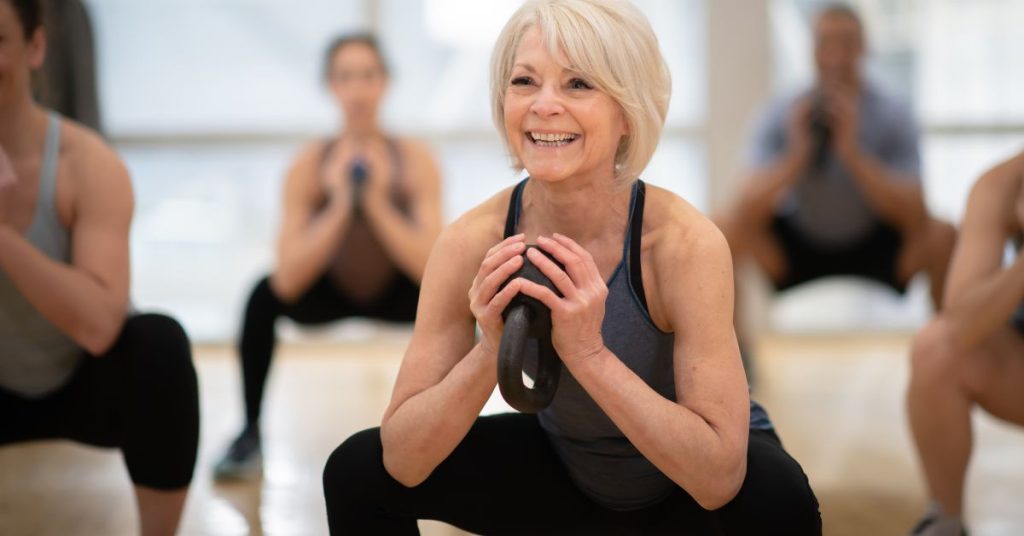

Calcium isn’t the only factor when it comes to strong bones. Exercise plays an important role in building and maintaining bone strength and preventing osteoporosis, so put down that glass of milk (it’s not doing you any favors) and pick up a set of dumbbells instead. Thirty to sixty minutes of weight-bearing and resistance exercise will support your bones far better than cow’s milk—even the chocolate variety. You can incorporate this effective, adaptable workout into your daily routine to support your bone health and prevent brittle bones down the road.
National osteoporosis organizations worldwide have agreed that weight-bearing and resistance exercises increase bone density and help prevent the onset of brittle bone disease. Weight-bearing does not necessarily mean using weights—it simply means supporting your own weight. For example, running, walking, yoga, dancing, tennis, and rock climbing are all considered weight-bearing activities, but swimming, cycling, and rowing are not.
Resistance exercise involves working against a force. You can do this with free weights, weight machines, resistance bands, or your body weight. This helps strengthen muscles, reducing the risks of falls and fractures.
The exercises below focus on body weight resistance exercises. Of course, if you want to pick up dumbbells to increase the intensity, we won’t stop you.
Complete four rounds of this circuit for a full bone-strengthening workout.
Squat and Raise (20 reps)
Stand with your feet slightly wider than hip-width distance apart. Sit back like you’re sitting in a chair until your knees reach a 90-degree angle (there’s no need to go lower). Keep your weight in your heels and make sure you can see your toes when you look down (if you can’t see your toes, shift your weight further back). Squeeze your glutes together, stand up straight again, and then raise your heels and reach upwards. Return your heels to the floor. That’s one rep.
Where you’ll feel it: Glutes, calves, quads
Tricep Push-Ups (10 reps)
Begin in a push-up position with your hands shoulder-width distance apart and your fingers pointing forward. Keeping your body in a straight line, bend your elbows straight back toward your ribs and lower until you’re two inches from the ground. Straighten your elbows to return to your starting position. That’s one rep. For a less intense option, stay on your knees instead of your toes.
Where you’ll feel it: triceps, shoulders, abs
Reverse Lunges (10 reps)
Stand with your feet together. Step one leg behind you and bend both knees to a 90-degree angle (your back knee should be hovering two inches above the floor). Be sure to keep your weight in your front heel so your front knee does not go past your toes. Pushing off the heel of your front foot, return to a standing position. Repeat the movement with your other leg. That’s one rep.
Where you’ll feel it: glutes, quads, balance
Up-Up-Down-Downs (10 reps)
Begin in a push-up position. Keeping your core and glutes tight and your body in a straight plank position, lower your forearms to the floor one at a time so that you’re in a forearm plank position. Immediately return to the push-up position by reversing the movement. That’s one rep. As much as possible, try to keep your hips from wiggling side to side.
Where you’ll feel it: shoulders, abs
Single-Leg RDL (10 reps per leg)
Stand with your feet together, then lift one foot off the floor. Keeping your abs tight and your back straight, slowly move your leg straight behind you, forcing your top half to reach down to the floor like a see-saw. Go as far down as you can while maintaining a straight back. Slowly return to a standing position. That’s one rep. Complete 10 reps and then switch legs.
Where you’ll feel it: hamstrings, balance
Flyers (20 reps)
Begin facedown on the floor with your arms stretched out in front of you (your elbows should be near your ears). Raise your chest and arms off the floor. Hold this raised position while you move your outstretched arms out to your sides and then to your back (fingers pointed toward your toes) in a continuous semi-circle movement—squeezing your shoulder blades together. Reverse the movement to return your arms to the starting position (keeping your chest raised the entire time). That’s one rep.
Where you’ll feel it: shoulders, back
Plank Series
Begin in a forearm side plank. Hold for 30 seconds. Switch sides and hold for 30 seconds more. Move to a standard forearm plank and hold for 30 seconds.
Where you’ll feel it: abs, shoulders
*This article is reprinted with permission from Switch4Good.
Copyright 2025 Center for Nutrition Studies. All rights reserved.